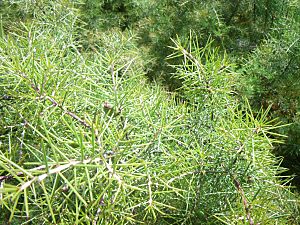Silky hakea facts for kids
Quick facts for kids Silky hakea |
|
|---|---|
 |
|
| Hakea sericea | |
| Scientific classification | |
| Genus: |
Hakea
|
| Species: |
sericea
|
 |
|
| Occurrence data from Australasian Virtual Herbarium | |
Hakea sericea, also known as bushy needlewood or silky hakea, is a large shrub that grows in eastern Australia. It is famous for its many white flowers that bloom for several months starting in July. This plant is native to Australia, meaning it naturally grows there and nowhere else. However, in some other countries, it has become a problem plant, growing where it's not wanted.
Contents
What Does Silky Hakea Look Like?
Silky hakea is a big, bushy shrub that can grow up to about 4 meters (13 feet) tall. Its branches are covered in soft, grey-white, woolly hairs.
Flowers and Leaves
The flowers of the silky hakea grow in small clusters of 1 to 6 blooms where the leaves meet the stem. They start as pinkish buds and open into beautiful white flowers. Each flower has a smooth outer part, called the perianth, and a long, slender pistil.
The leaves are shaped like needles, about 7 centimeters (2.8 inches) long and very thin, less than 1 millimeter wide. They have a sharp point at the end. When they are young, the leaves have a few silky hairs, but they quickly become smooth.
Fruit of the Silky Hakea
After flowering, the plant produces interesting fruits. These fruits are rough and wrinkled, with a pattern of veins on their surface. They are about 2.5 to 3 centimeters (1 to 1.2 inches) long and 2 centimeters (0.8 inches) wide. Each fruit ends with a short, wide beak.
Where Does Silky Hakea Grow?
Silky hakea is found along the coast and nearby mountain ranges in south-eastern Queensland and south-eastern New South Wales in Australia. It can handle frost and prefers to grow in soil that drains well, in sunny spots. Because its leaves are prickly and it flowers in winter, it provides a good home for some animals. It has also started growing naturally in Victoria and possibly South Australia.
Silky Hakea as an Invasive Plant
Outside of Australia, Hakea sericea can be an invasive weed. This means it spreads quickly and can take over areas, harming local plants and ecosystems. It has become a problem in places like South Africa, New Zealand, and Portugal.
Naming the Silky Hakea
The scientific name Hakea sericea was first officially described in 1797 by two botanists, Heinrich Adolph Schrader and Johann Christoph Wendland. The name Hakea comes from Baron von Hake, who was a supporter of botany (the study of plants) in the 18th century. The word sericea means "silky," which refers to the tiny, soft hairs found on the plant's young branches and leaves.
Images for kids


